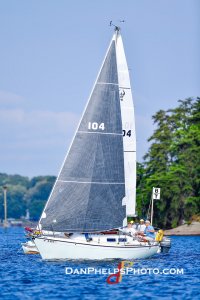Hi Forum Members,
I am looking for input specific to an E25 Mark 1 on tuning the rig for pointing ability. We raced "Janie Ann" in a multi day regatta this past weekend and did well, came in 2nd place for my division. The picture below is at the start of the first race on Saturday. But of course I want to do better next year and so looking for improvements or differences between us and the boat that took first, a Tanzer 22 full keel masthead rig. The biggest thing that stood out was that we did not point anywhere near as well, and the skipper of that boat said the same thing at the awards ceremony, that my pointing lower was the main thing that kept him ahead. Of course he is also a very good skipper. Our boat speed was a little better both in light winds the first day and 10-15 knots the second day, but he pointed at least 5 to 7 degrees higher (a guess from both of us) in all conditions and so steadily moved away from us to windward gaining ground on every tack. In contrast I will say we seemed to point just as well as the the other boats in my division (Catalina 27, Catalina 28, Pearson 27, Hunter 280, etc.) who we beat.
The Ericson owners manual offers very little in the way of tuning the rig, saying only that the mast should be vertical and in column. I struggle to believe that it should have zero rake, and right now it is close to zero, around 1 degree. Mast is in column under load, and the shroud tensions are set with a Loos gauge and then adjusted under sail. Anybody have experience with the E25 racing? Experience in what is the best tuning setup for that specific boat? Or even knowledge on the E25 CB pointing ability? Perhaps they just are not as good pointing as the Tanzer 22. Would welcome any suggestions.

I am looking for input specific to an E25 Mark 1 on tuning the rig for pointing ability. We raced "Janie Ann" in a multi day regatta this past weekend and did well, came in 2nd place for my division. The picture below is at the start of the first race on Saturday. But of course I want to do better next year and so looking for improvements or differences between us and the boat that took first, a Tanzer 22 full keel masthead rig. The biggest thing that stood out was that we did not point anywhere near as well, and the skipper of that boat said the same thing at the awards ceremony, that my pointing lower was the main thing that kept him ahead. Of course he is also a very good skipper. Our boat speed was a little better both in light winds the first day and 10-15 knots the second day, but he pointed at least 5 to 7 degrees higher (a guess from both of us) in all conditions and so steadily moved away from us to windward gaining ground on every tack. In contrast I will say we seemed to point just as well as the the other boats in my division (Catalina 27, Catalina 28, Pearson 27, Hunter 280, etc.) who we beat.
The Ericson owners manual offers very little in the way of tuning the rig, saying only that the mast should be vertical and in column. I struggle to believe that it should have zero rake, and right now it is close to zero, around 1 degree. Mast is in column under load, and the shroud tensions are set with a Loos gauge and then adjusted under sail. Anybody have experience with the E25 racing? Experience in what is the best tuning setup for that specific boat? Or even knowledge on the E25 CB pointing ability? Perhaps they just are not as good pointing as the Tanzer 22. Would welcome any suggestions.



![FB_IMG_1633707014489[8983].jpg FB_IMG_1633707014489[8983].jpg](https://ericsonyachts.org/ie/data/attachments/31/31196-fa105ff5c47b977fee6186c4e1fc08c5.jpg)